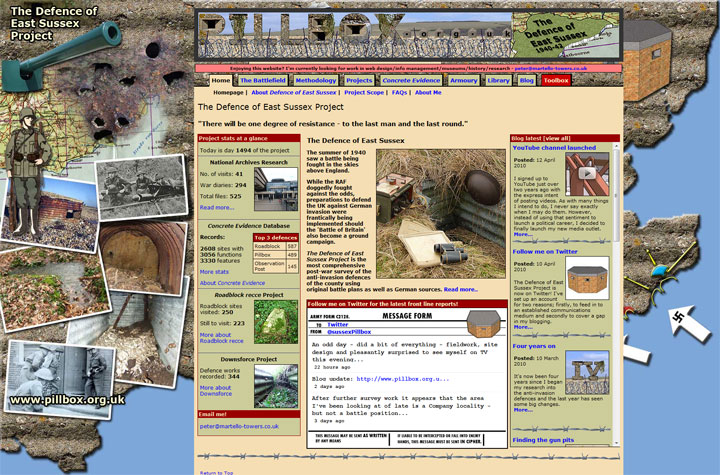YouTube channel launched
Posted: 12 April 2010 20:45
I signed up to YouTube just over 2 years ago with the intent of posting videos. As with many things I intend to do, I never say exactly when I may do them. However, instead of using that sentiment to launch a political career, I decided to finally launch my new media outlet.
As with my new Twitter account, my YouTube username is sussexPillbox. The YouTube ID actually inspired the Twitter username as I had the good sense to go back before I joined Twitter to see what I'd used for YouTube. This process actually reawakened my interest in finally activating my channel. Until now, I had been embedding video clips on the website myself but this had some downsides, namely the amount of webspace each video file took up (webspace=money) and the hassle of editing the video to reduce length, filesize and quality. YouTube relieves me of the need to compress videos to suit my current webspace allocation; I can now just knock out a video at reasonable quality, upload and let somebody else worry about making it work online. I'm also wanting to be reaching out to a wider audience, and, as with Twitter, a pre-existing global network seems to be the best place to do it. As with Twitter, I'm still finding my way with all the features and tools on offer.
One thing that had previously put me off using non-Hibbsy-built systems (despite their global presence and usage) was the seeming lack of control over the look and feel of user interface. In other words, as a web designer, I would love to be able to make my Twitter and YouTube accounts an extension of my website in a way that makes movement between them almost seamless.
Signing up to YouTube and trying to make my channel page look even remotely like my website was initially disappointing, as, although power to change background and text colours was one thing, this was not enough to really stamp my brand, and perhaps the reason why I put it on hold.
Finally (almost reluctantly) signing up to Twitter presented me with the same branding problems; what I really wanted to do was put my banner image across the top. However, I experienced an epiphany as I looked at what others were doing on Twitter; they were using their background image to reinforce their brand.
I then realised that although I couldn't put my branding in the same place as it appears on my website, it didn't mean that it couldn't be there, hence my devising the background image that now adorns both my Twitter and YouTube pages. A further enlightenment was that I could use the same image to actually rebrand the main website and make it look like the Twitter and YouTube channels that were trying to imitate it. So although my brand still remains in my banner image and colour scheme, it has partly shifted to a high-impact background image that provides instant recognition.
The images below show the background in use:
YouTube:

Twitter:

Experimental website background:

As can be seen, there are problems caused by the width of the content area of each site; the image was designed for the Twitter content box, but YouTube and the main website are wider. There are also problems as screen width causes different areas of the background to be obscured by the content, and while the Twitter background is fixed, YouTube's moves down as the page scrolls. The new background image is here to stay as a branding tool but it still needs tweaking, so beware of some changes here and there as I make some adjustments!
- Pete

Email:
Blog Latest

Bishopstone reveals its pillbox secrets
18 October 2021

Pillbox or Observation Post?
10 June 2020

Uncovering the hidden secrets of a pillbox
8 June 2019

Review of 2018
31 December 2018

Wartime Christmas in East Sussex (2)
24 December 2018
Jargon-buster
Pillbox
Generic term for a hardened field defensive structure usually constructed from concrete and/or masonry. Pillboxes were built in numerous types and variants depending on location and role.
This site is copyright © Peter Hibbs 2006 - 2024. All rights reserved.
Hibbs, Peter YouTube channel launched (2024) Available at: http://www.pillbox.org.uk/blog/216657/ Accessed: 20 April 2024
The information on this website is intended solely to describe the ongoing research activity of The Defence of East Sussex Project; it is not comprehensive or properly presented. It is therefore NOT suitable as a basis for producing derivative works or surveys!